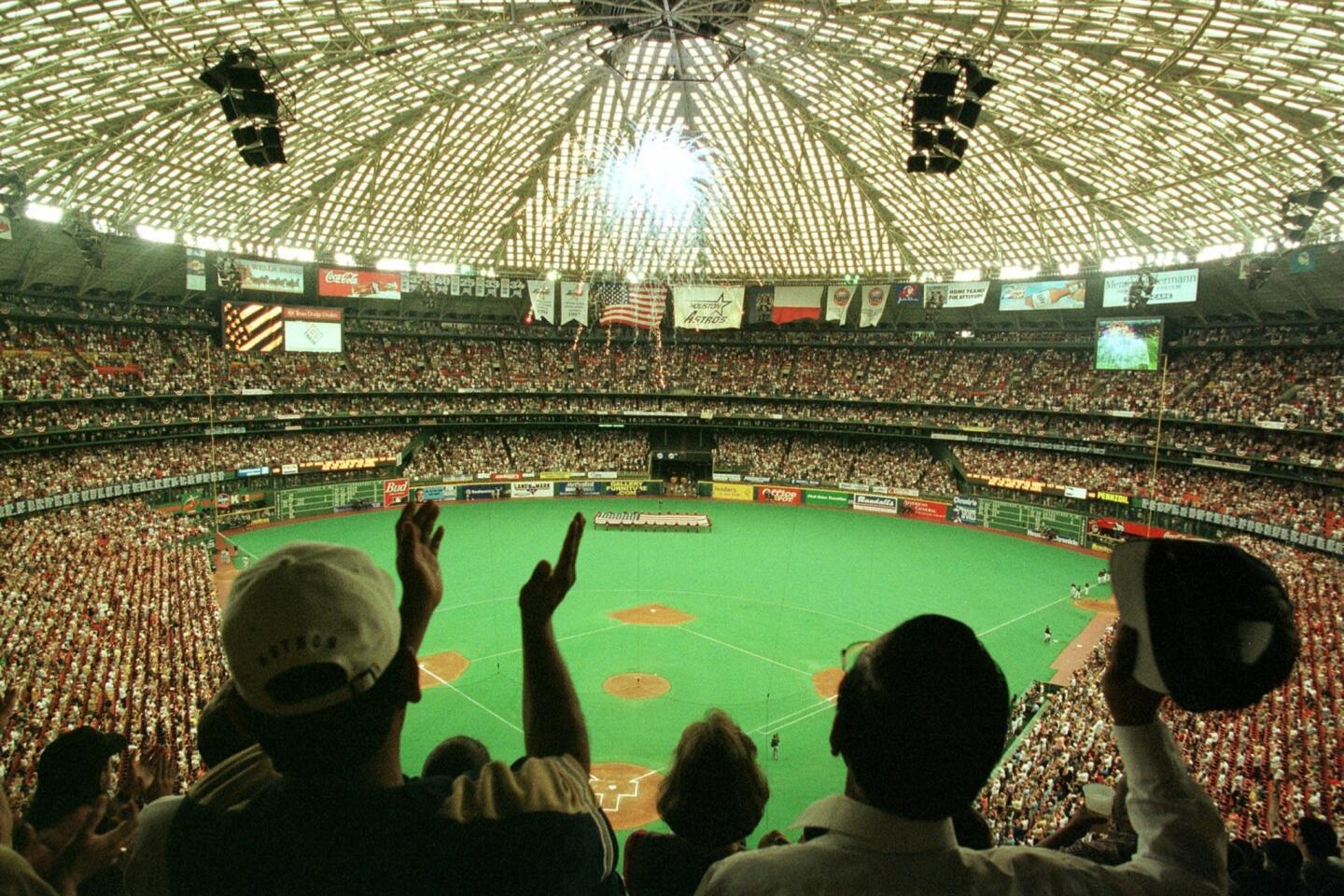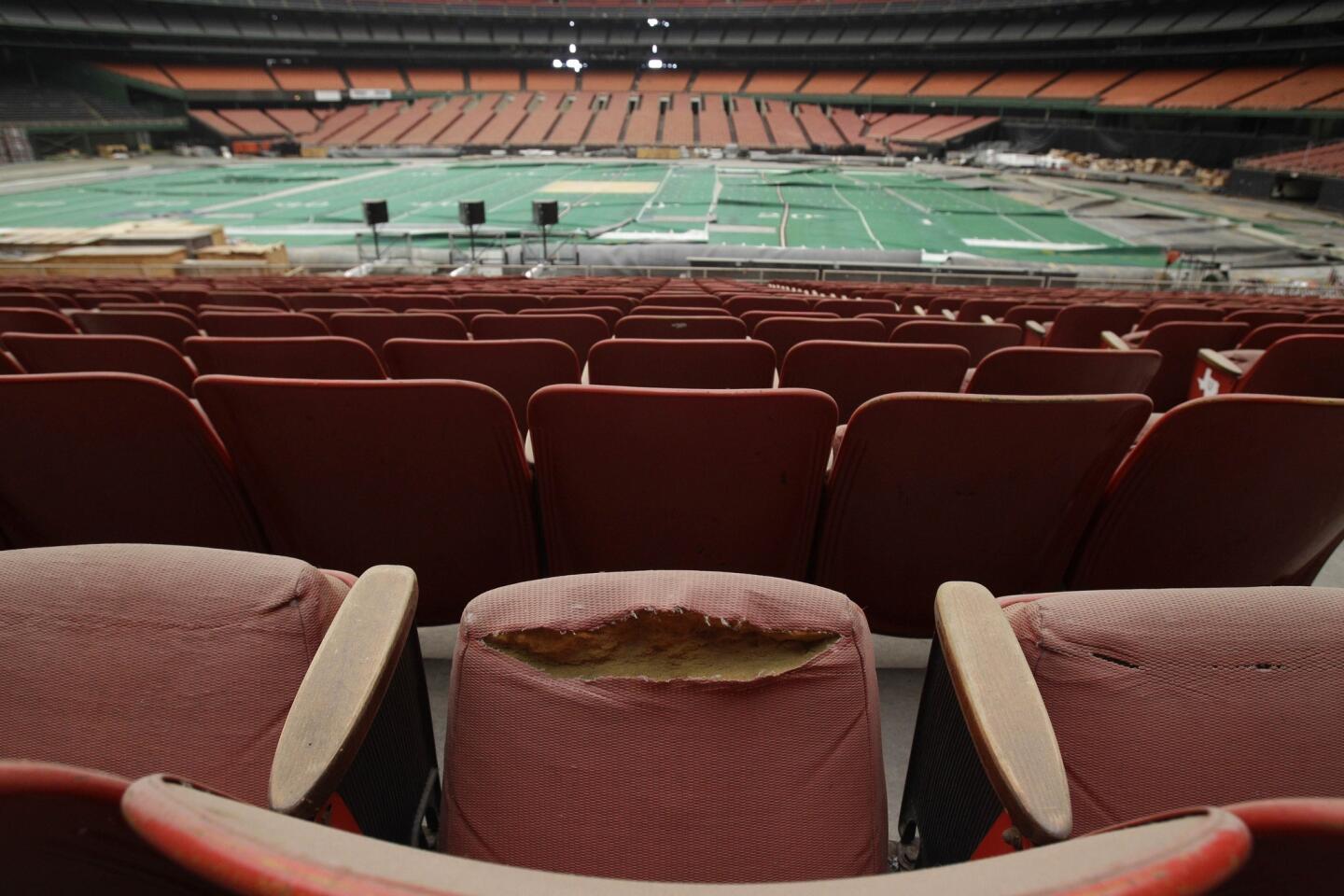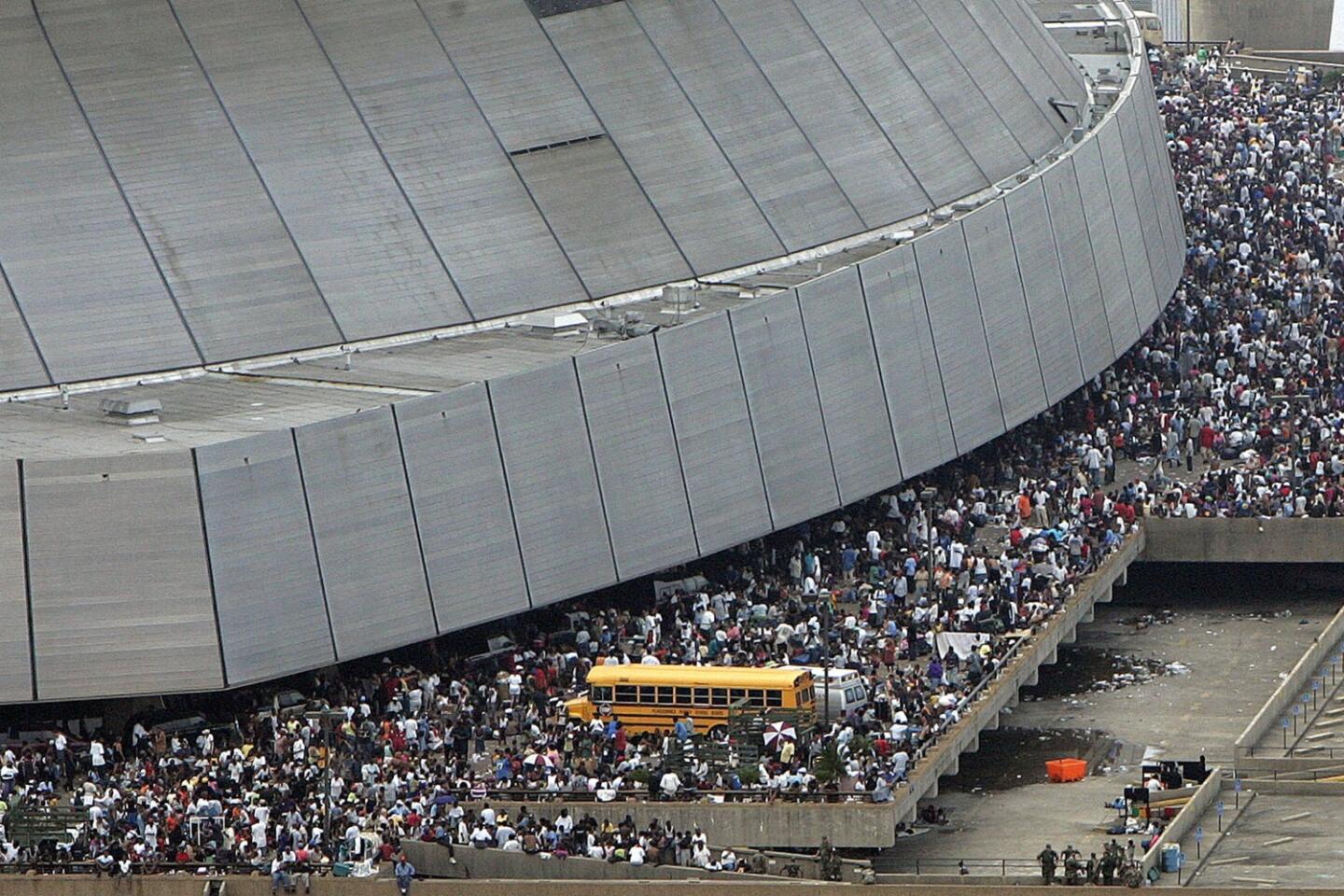Why the Astrodome is worth saving
- Share via
HOUSTON — Forget Monticello or the Chrysler building: There may be no piece of architecture more quintessentially American than the Astrodome.
Widely copied after it opened in 1965, it perfectly embodies postwar U.S. culture in its brash combination of Space Age glamour, broad-shouldered scale and total climate control.
It also offers a key case study in how modern architecture treated the natural world — and how radically the balance of power in that relationship has shifted over the last half-century.
Domed stadiums once provided a symbol of how eager American architects were to completely seal their buildings off from nature. Now they suggest the essential futility of that effort.
CHEAT SHEET: Fall arts preview
The Astrodome, for all that rich history, has languished empty, unused and threatened with demolition for nearly five years.
On Tuesday voters in Harris County, which includes Houston, will decide whether to raise $217 million to save the stadium and turn it into a multipurpose event center. If the measure fails, it could be razed within a few months.
The brainchild of a colorfully shrewd former Houston mayor and county judge, Roy C. Hofheinz, the Astrodome opened on April 9, 1965, for an exhibition game between the Astros, an expansion baseball team awarded to Houston three years earlier, and the New York Yankees. President Lyndon B. Johnson watched the game from Hofheinz’s suite. The Oilers played pro football there from 1968 to 1996.
The Astrodome was designed by Houston architects Hermon Lloyd and W.B. Morgan in collaboration with local firm Wilson, Morris, Crain and Anderson. Partial design credit should also go to the inventor and polymath Buckminster Fuller, who was experimenting with dome construction at the time and gave Hofheinz early architectural advice.
ART: Can you guess the high price?
The Astrodome’s exterior is wrapped in a steady, repeating rhythm of slender columns, the space between them filled with concrete screens in a delicate diamond-shaped pattern. Seen from the parking lot outside, the dome resembles more than a few lightly ornamented postwar buildings around the country, including William Pereira’s Los Angeles County Museum of Art, which opened the same year.
The playing surface is sunk 30 feet below ground, keeping the stadium’s exterior profile surprisingly modest.
But inside it was a revelation from the start. The roof span of 642 feet created the biggest single room ever built. The temperature was kept in the low 70s.
And the air was not just cool. It was dry, a great relief for Houstonians used to suffering through summertime baseball games on steamy, buggy nights. At the small temporary stadium where the team played while the Astrodome was under construction, you could buy fly swatters at the concession stands.
PHOTOS: LA Opera through the years
Countless design details also suggested Houston’s interest, four years after John F. Kennedy announced he wanted to put a man on the moon, in transforming itself from “Bayou City” to “Space City.” Groundskeepers wore astronaut suits. The female ushers were known as “Spacettes.”
There were also hints of a Cold War outlook in the building’s heft and seeming impenetrability. The stadium was part spaceship, part bunker.
That first season, in 1965, the Astros played on real grass. But the sunshine streaming through the Lucite panels in the roof created a glare that was distracting to fans and especially to outfielders trying to catch fly balls. The panels were painted over. The grass died.
The team asked Monsanto about using the company’s new synthetic grass, called “Chemgrass,” for the 1966 season. Monsanto officials renamed the material Astroturf and sold it under that name around the world.
There were echoes in the design of earlier architecture, but the Astrodome’s attitude was wholly modern and forward-looking. The Pantheon in Rome, the touchstone for all domed architecture, has an open oculus. On rainy days its floor is wet.
At the Astrodome there was no such negotiation between structure and weather. Climate was something American architecture, by the 1960s, had decided it could banish altogether, render obsolete.
In recent years, however, the symbolism of domed architecture has been turned inside out. A building type once synonymous with confidence and American engineering prowess is now more closely associated with environmental anxiety.
In 2005 Hurricane Katrina battered the Louisiana Superdome, built in the 1970s in New Orleans using the Astrodome as a blueprint, tearing open its tightly sealed roof and pouring rain and misery on the storm victims seeking shelter below. Soon many of those evacuees were bused west to Houston, where they spent two weeks sleeping on cots inside the Astrodome.
PHOTOS: Hollywood stars on stage
The domes were staples of Katrina news coverage, emblems of our growing difficulty in grappling with and preparing for more frequent hurricanes, global warming, rising sea levels and other environmental threats. Katrina’s aftermath had pierced even Hofheinz’s tightly sealed pleasure dome.
On Saturday the Harris County Sports and Convention Corporation, which operates both the Astrodome and the adjacent Reliant Stadium, where the NFL’s Houston Texans have played since 2002, held what it called an “Astrodome Yard Sale and Live Auction.” It was a sort of prelude to the vote on Proposition 2, the bond measure that will decide the Astrodome’s fate.
Once a long, slow-moving line brought buyers inside a conference center next door to the Astrodome, they found rows of items including squares of Astroturf in various sizes ($20 and up), bright orange seats ($200 a pair) and other pieces of memorabilia taken from the stadium.
Harris County spends roughly $2 million to $3 million each year on basic maintenance and security for the Astrodome. Demolishing it would free the county of that burden — and open up more parking spaces and tailgating room for Texans games.
INTERACTIVE: Tour Los Angeles’ boulevards
I walked through the Astrodome on Saturday afternoon as the sale was wrapping up. On the dusty concrete floor was nearly a half-century worth of sports-related detritus, including old batting cages and piles of Astroturf. The place looks as though it was abandoned in a rush.
But all I had to do to understand the full appeal of the architecture was look up toward the center of the massive steel-framed roof, more than 200 feet above my head. Light filtered through its hundreds of panels fell serenely on the rest of the vast interior. Seen from that vantage point, the building has lost none of its tremendous aesthetic power.
Recent polls suggest that Harris County voters, despite Houston’s reputation as a city that prefers new architecture to old, are leaning toward approving Proposition 2. If that happens, the county will soon begin renovation work.
Renderings produced by Houston firm Kirksey Architecture and circulated by supporters of the measure show the floor of the dome remade to hold trade shows, skateboarding competitions and other events. Four new rectangular entry portals would be slotted into the stadium’s exterior.
Those designs can (and should) be improved over time. What matters now is keeping the dome upright.
Even if its attitude toward the environment now strikes us as deeply naive, the Astrodome deserves to be protected simply as a singular monument to the American confidence and Texas swagger of the 1960s. The stadium doesn’t so much symbolize as perfectly enclose a moment in time.
christopher.hawthorne@latimes.com
More to Read
The biggest entertainment stories
Get our big stories about Hollywood, film, television, music, arts, culture and more right in your inbox as soon as they publish.
You may occasionally receive promotional content from the Los Angeles Times.


















